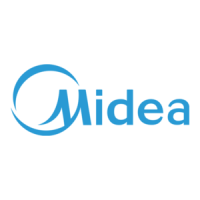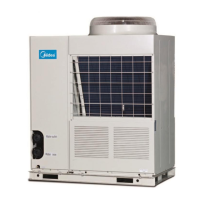
Do you have a question about the Midea MH-SU65-RN8L and is the answer not in the manual?
Specifies operating conditions and temperature ranges for the unit's performance.
Provides guidelines for safely moving and handling the unit during installation.
Shows the physical dimensions of the unit for installation planning.
Specifies the necessary clearance and spacing around the unit for proper airflow and access.
Details the requirements and methods for creating a stable and suitable foundation for the unit.
Explains how to install vibration damping devices between the unit and its foundation.
Offers measures to protect the unit from snow accumulation and strong winds.
Identifies and lists the main components of the unit with diagrams.
Explains how to access different compartments of the unit by opening its doors.
Details the Printed Circuit Boards (PCBs) located in the outdoor unit.
Provides essential safety cautions and general guidelines for wiring the unit.
Outlines specific precautions for electrical wiring, including standards and cable types.
Details the power supply requirements, including voltage, current, fuse, and wiring specifications.
Illustrates correct and incorrect methods for power supply wiring and grounding.
Shows the proper and improper ways to connect the power cord to the unit.
Explains the function of various terminals for communication and control.
Details how to wire the remote ON/OFF control function for the unit.
Describes wiring for selecting target water temperatures via wired controller.
Explains how to connect devices to the ALARM ports for abnormal operation indication.
Provides precautions for control system wiring, shielding, and layout.
Illustrates typical wiring configurations for networked units.
Outlines fundamental requirements for connecting chilled water pipelines.
Details the pipe connection methods and specifications for different models.
Guides on designing and installing a store tank for system water content requirements.
Specifies the minimum required chilled water flow rate.
Details the maximum allowable chilled water flow rate.
Covers the selection criteria and installation procedures for the system pump.
Discusses the importance of water quality and necessary treatments for the system.
Provides guidance for installing multi-module water systems and pipe diameters.
Details DIP switch settings and installation for single/multiple water pumps.
Advises on gradual heating during initial startup at low temperatures to prevent floor damage.
Lists crucial checks and preparations before conducting the trial run.
A checklist of items to verify after the unit has been installed.
Describes the process and duration for conducting the trial run of the unit.
Lists failure codes displayed by the unit and their meanings.
Explains the information displayed on the main board's digital display.
Provides recommendations for regular care and maintenance of the unit.
Details the process for removing scale from the water-side heat exchanger.
Guides on procedures for shutting down the unit during winter to prevent freezing.
Specifies using only manufacturer-provided parts for replacements.
Outlines preparations for restarting the unit after a long shutdown period.
Covers checks, leak detection, and refrigerant injection for the system.
Provides steps for safely disassembling the compressor.
Discusses the use of an auxiliary electric heater for low temperatures.
Emphasizes the importance of antifreezing measures to prevent damage.
Details the procedure for replacing the unit's safety valve.
Provides essential information and safety checks for servicing the refrigeration system.












